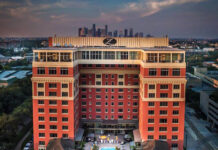If Josh Wyatt ever really struck it rich, he’d get rid of all his possessions and travel the world. The 41-year-old chief strategic officer of Generator Hostels is far more interested in having great experiences than getting bogged down by clutter. “I don’t need a big fancy car, a huge McMansion, or 5,000 square feet of spaces I’d never go into anyways,” Wyatt says.
Generator, known for its design-led hostels throughout Europe, is built around the same ethos: light footprint, big impact. “Small is very beautiful in a lot of ways,” Wyatt says.
On average, a Generator hostel fits approximately 150 rooms with a total of 600 beds into 60,000 square feet. The brand offers affordable lifestyle accommodations in urban cities, such as Barcelona, Berlin, Dublin, London, and Paris, without skimping on design, quality, and comfort. Wyatt describes the guestrooms as sleek and elegant but minimal. When you factor in all the other ingredients, the guest experience feels anything but small. The energetic public areas are complete with a café, a bar, ping-pong or pool tables, and other social spaces that bring travelers together. The brand also partners with local businesses and offers programming that drives a sense of community, such as game nights, mixology demos, live music events, and art exhibits.
All of Generator’s properties—nine and counting—are adaptive reuse projects that have been molded to the personality of the building and the local environment. “If you don’t give a local touchpoint, it’s hard to remember where you are sometimes,” Wyatt says. “I’m on the road 20 days a month, and if I’m staying in a generic brand hotel, sometimes I forget where I am.”
As consumer values shift, it becomes more important to design well rather than waste money and resources on big buildings, Wyatt says. From the tiny house movement to low carbon living, an increasing number of consumers are embracing a less-is-more mentality. Fueled by an economic and environmental necessity to build smarter and more efficiently, many hotel companies are finding ways to deliver big things in small packages. Tiny guestrooms—less than 200 square feet—are offset by multi-zone lobbies, creative programming, high-touch design, and tech-forward features. In the last few years, European brands like Yotel and CitizenM have successfully imported their micro-room concepts to the United States, while new lifestyle brands such as Best Western’s Vib, Marriott’s Moxy, and Commune’s Tommie similarly boast a small-footprint, Euro-inspired formula.
The micro-hotel concept is not completely new to the United States. Hoteliers Richard Born and Ira Drukier gave it a go back in 2007 when they introduced Pod Hotels to New York City. Although those hotels are at the extreme end of the spectrum, with rooms that range from 60 to 120 square feet, the notion of offering vibrant communal spaces, high-tech amenities, and innovative programming at an attractive price point is increasingly common in the hotel industry.
CRAVING CONTENT
Benjamin Trigano, who co-founded French boutique chain Mama Shelter with family members in 2008, sees a new generation of hotels emerging where creative design reigns supreme and proper emphasis is placed on what’s truly relevant for the younger generation—content. The brand introduced its first U.S. location in Los Angeles in July. “Some people think having hip decorations, cranking up loud music, and partnering with a famous branded restaurant makes it a great experience,” Trigano says. “That [train of thought] is at the end of its life.”
Mama Shelter offers a range of guestroom sizes at each of its six locations, and they have all been designed with efficiency in mind, with some rooms as small as 150 square feet. The brand enlisted French designer Philippe Starck, whose notable hotel projects include the Royalton in New York, the Delano in Miami, the Mondrian in Los Angeles, and SLS Hotels, to create Mama Shelter’s look. Thierry Gaugain, former head of design at Starck’s firm, designed the L.A. location. “We try to put money where we think people will care—the bed, the TV, the quality of the bathroom,” Trigano says. “Making them pay a lot of money for a bigger room doesn’t make any sense.”
For Mama Shelter, unique spaces and social experiences trump what’s cool or trendy. With its open design concept, common areas flow into each other and transform from day to night. “It’s like your rich uncle’s country house where people hang out, have breakfast, play games, and listen to music at night,” Trigano says.











